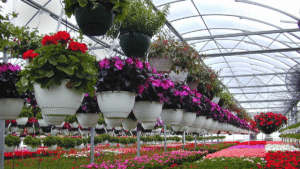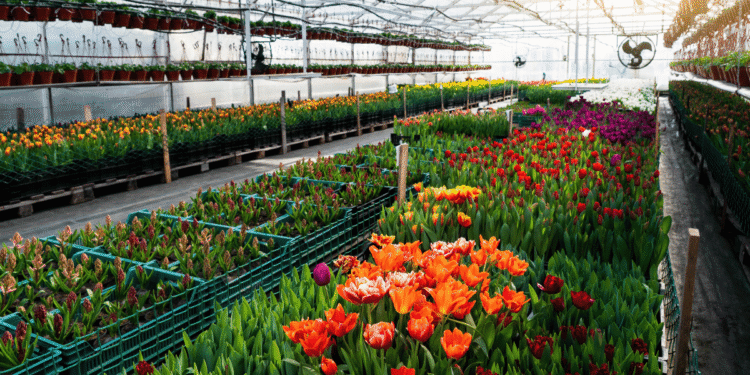Flowers, with their captivating colours, delicate petals, and intoxicating fragrances, have long held a special place in human culture and aesthetics. Beyond their beauty, flowers play a pivotal role in various aspects of our lives, from celebrations and ceremonies to expressions of love and condolences. This has given rise to a flourishing industry known as floriculture. In this article, we delve into the fascinating world of floriculture, exploring its history, significance, and the captivating facts that make it a blooming business.
Understanding Floriculture
Floriculture is the art and science of cultivating and marketing ornamental and flowering plants, commonly referred to as cut flowers and potted plants. These plants are grown for various purposes, including decorative arrangements, landscaping, gift-giving, and horticultural exhibitions. The floriculture industry encompasses a wide range of players, from small-scale flower growers to large commercial nurseries and floral designers.
Historical Roots
The practice of cultivating flowers for aesthetic purposes dates back to ancient civilizations. The ancient Egyptians, Greeks, and Romans all appreciated the beauty of flowers and incorporated them into their art, architecture, and religious ceremonies. The formal cultivation of flowers for ornamental purposes began to take shape during the Renaissance period in Europe, where wealthy patrons created grand gardens filled with diverse and exotic plant species.
Significance and Uses

Floriculture holds immense significance in various cultural, social, and economic contexts:
- Aesthetic Beauty:
The primary appeal of floriculture lies in the exquisite beauty of flowers. They enhance indoor and outdoor spaces with vibrant colours, unique shapes, and soothing fragrances, creating a visually appealing environment.
- Expressing Emotions:
Flowers have a language of their own, allowing individuals to convey emotions and sentiments without words. Different flowers carry symbolic meanings – roses symbolize love, lilies signify purity, and sunflowers represent happiness.
- Celebrations and Events:
Floriculture plays a vital role in celebrations and events, such as weddings, birthdays, anniversaries, and religious ceremonies. Floral arrangements and bouquets are integral elements of decor that enhance the ambiance of these occasions.
- Funeral and Mourning:
Flowers are also used to express sympathy and offer condolences during times of mourning. They provide comfort and serve as a visual tribute to the deceased.
- Economic Impact:
The floriculture industry contributes significantly to the global economy. Cut flowers and potted plants are traded internationally, generating substantial revenue and providing employment opportunities in various countries.
- Therapeutic Value:
Studies have shown that exposure to flowers and nature can have a positive impact on mental well-being, reducing stress and promoting relaxation. This therapeutic aspect further underscores the significance of floriculture.
Captivating Facts
- Global Trade:
Floriculture is a truly global industry. Flowers are cultivated in various climates and regions, from tropical rainforests to temperate zones, and are traded internationally to meet the demands of different markets.
- Valentine’s Day:
Valentine’s Day is one of the busiest periods for florists. The demand for roses, especially red ones, skyrockets as people express their love and affection through these classic symbols of romance.
- Dutch Dominance:
The Netherlands is often referred to as the “flower shop of the world.” It is a global leader in flower production and exports, particularly tulips. The country’s Keukenhof Gardens is a world-famous showcase of diverse and stunning flower varieties.
- Orchid Obsession:
Orchids, with their intricate and diverse shapes, are among the most sought-after flowers for both ornamental and scientific purposes. They have become symbols of luxury and refinement.
- Sustainable Practices:
As environmental awareness grows, sustainable floriculture practices are gaining prominence. From organic cultivation methods to eco-friendly packaging, the industry is evolving to reduce its ecological footprint.
- Flower Festivals:
Flower festivals around the world, such as the Rose Parade in the United States and the Chelsea Flower Show in the United Kingdom, attract thousands of visitors who marvel at breathtaking floral displays and innovative arrangements.
- Ikebana:
The Japanese art of flower arrangement, known as Ikebana, emphasizes harmony, balance, and simplicity. It has a deep spiritual and cultural significance in Japan and around the world.
Starting a floriculture business in India can be a rewarding and profitable endeavor. India is one of the world’s leading producers of flowers, and there is a growing demand for both domestic and international markets.
How to start a floriculture business in India?

Conduct Market Research and Develop a Business Plan
Before embarking on your floriculture journey, it’s essential to conduct thorough market research to understand the demand for different types of flowers, the pricing of flowers in the market, and the competitive landscape. This information will guide your decision-making process and help you develop a comprehensive business plan.
Choose a Suitable Location and Land
The location of your floriculture business will play a crucial role in its success. Consider factors such as proximity to markets, transportation infrastructure, access to water and electricity, and soil suitability for flower cultivation.
Select the Right Flower Varieties
The selection of flower varieties will depend on the climatic conditions of your region, market demand, and your expertise in cultivating specific flowers. Choose varieties that are well-adapted to the local climate and have a strong market demand.
Establish Proper Infrastructure and Facilities
Ensure that you have the necessary infrastructure and facilities to support your floriculture business. This includes greenhouses, shade houses, irrigation systems, storage facilities, and packing and grading equipment.
Acquire the Necessary Licenses and Permits
Obtain the required licenses and permits from the relevant government authorities, such as the Agricultural and Processed Food Products Export Development Authority (APEDA) and the local horticulture department.
Source Quality Seeds and Planting Materials
Procure high-quality seeds and planting materials from reliable suppliers to ensure healthy growth and high-quality flower production.
Implement Proper Cultivation Practices
Adopt appropriate cultivation practices, including soil preparation, planting techniques, irrigation management, pest and disease control, and fertilization, to optimize flower yield and quality.
Establish Market Linkages
Develop strong market linkages with wholesalers, retailers, and exporters to ensure a steady demand for your flowers. Attend trade shows and networking events to connect with potential buyers.
Build a Strong Brand Identity
Create a unique and recognizable brand identity for your floriculture business. This includes developing a logo, establishing a consistent brand voice, and maintaining a professional online presence.
Invest in Marketing and Promotion
Utilize various marketing channels, such as social media, print and online advertisements, and participation in local events, to promote your floriculture business and reach a wider audience.
Provide Excellent Customer Service
Prioritize customer satisfaction by providing excellent customer service, maintaining the quality of your products, and ensuring timely delivery.
Stay Updated on Industry Trends and Technology
Continuously update your knowledge of industry trends, advancements in cultivation techniques, and emerging technologies to adapt and enhance your floriculture business.
Remember, success in the floriculture industry requires dedication, hard work, and a passion for flowers. By carefully planning, implementing effective strategies, and adapting to market demands, you can establish a thriving floriculture business in India.
Future Trends
As society evolves and embraces sustainability, the floriculture industry is undergoing transformative changes:
- Local and Seasonal:
There is a growing interest in locally grown and seasonal flowers, reducing the carbon footprint associated with long-distance transportation and fostering a connection to the local environment.
- Organic and Eco-Friendly:
Consumers are increasingly seeking flowers produced using organic and eco-friendly practices that minimize the use of synthetic chemicals and promote soil health.
- Floral Design Innovation:
Floral designers are pushing creative boundaries by experimenting with unconventional materials and avant-garde arrangements that challenge traditional norms.
- Digital Engagement:
Technology is playing a role in connecting consumers with florists and flower growers through online platforms, allowing for customized orders and doorstep delivery.
Conclusion
Floriculture transcends mere horticulture; it is a dynamic blend of art, culture, and commerce. As flowers continue to captivate our senses and touch our hearts, the business of floriculture blooms with innovation, diversity, and a commitment to sustainable practices. From celebrations to solace, from cultural traditions to expressions of love, the world of flowers enriches our lives and reminds us of the delicate yet powerful beauty that nature bestows upon us. As we embrace the captivating world of floriculture, we are invited to explore the intricate tapestry of human emotions, aesthetics, and connections that are woven into every delicate petal and vibrant bloom.











